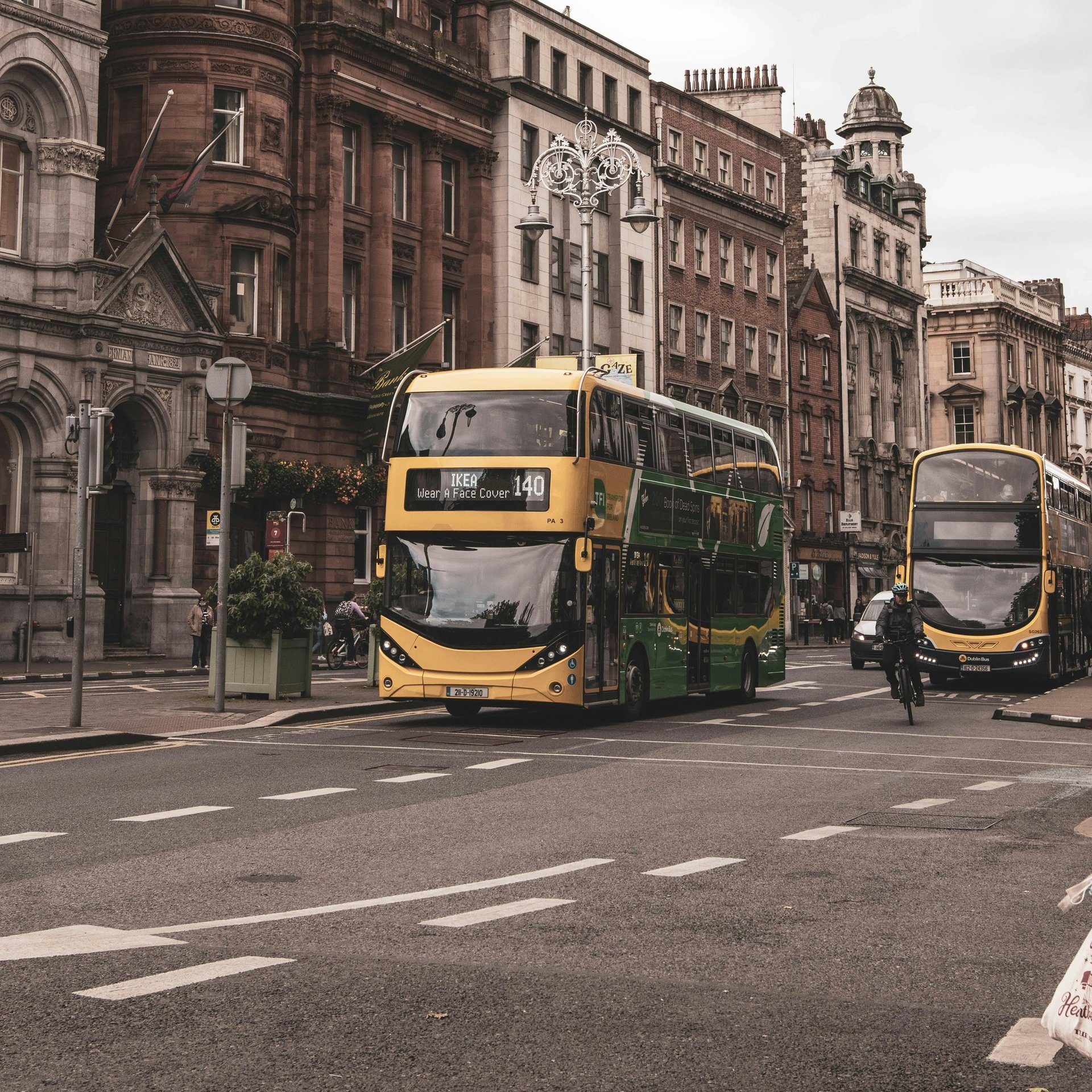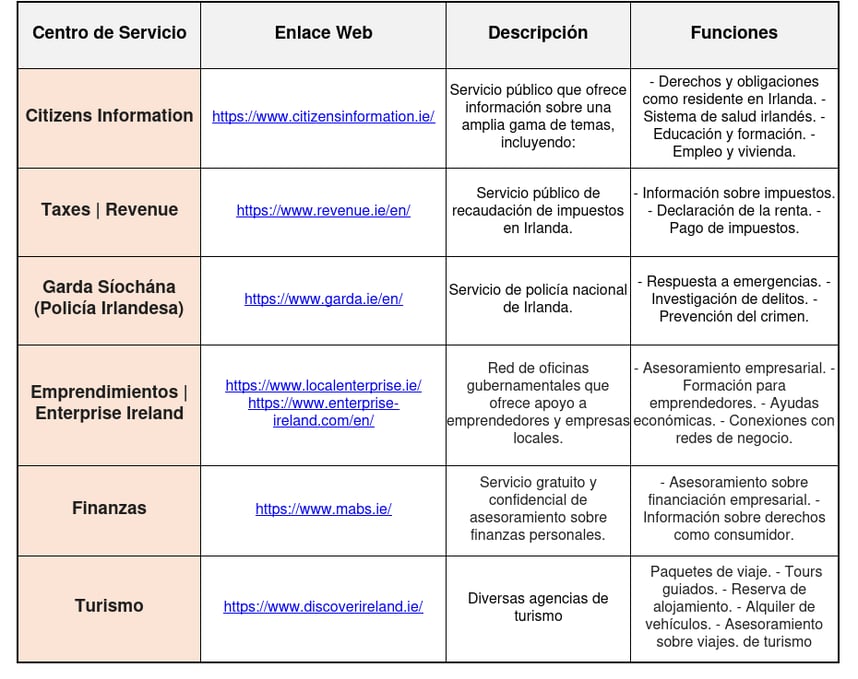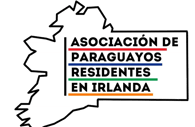
Live in Ireland. Guide created by APRI.
When we talk about living in Ireland, home to many, and our community of residents, it is a real adventure, and like any adventure, there are its challenges and satisfactions, and even more so when it is an unknown country to you, in this article we are going to give you valuable and useful tips, that give you a hand of guidance, advice, tips, for you to know, more about the functioning of services that you may need or may be of interest.
More information
Work in Ireland
Alianzas consulares


TABLE OF CONTENTS
Introduction


...
Discover Ireland
Type of transports. How works.
Overview:
Public transportation in Ireland is comprehensive, offering a variety of options.
Buses: Double-decker buses, similar to those in London, are a popular way to get around.
Trams: Luas trams operate in urban areas.
Buses and trains: Connect cities and towns throughout the country.
The relatively small size of Ireland makes it easy to travel around.
Total area: 70,273 square kilometers (km²)
Dublin (capital city): 114.99 square kilometers (km²)
Government-provided options:
Bus Éireann: National bus company
Luas: Tram system in Dublin
Payment:
Leap Card: The main payment method for public transportation.
Purchase options:
In-store at many stores (e.g., Spar, Centra, Mace)
Online with delivery to your home
Top-up options:
Leap Card Top Up app (Android and iOS)
TFI Live App (real-time bus information)
More information:
Transport for Ireland website: https://www.transportforireland.ie
Other transportation options:
Taxis and Uber
Biking (DublinBikes): A popular and eco-friendly option
Website: https://www.dublinbikes.ie/
App: Available for iOS and Android
Network of stations: Over 150 stations in Dublin
Bike types: Standard and electric bikes
Prices: Casual rental from €3 per trip, annual memberships from €20
Tips:
Be aware that traffic drives on the left-hand side of the road in Ireland.
Walking is a popular and healthy way to get around, especially in cities.
Apps like FREE NOW and Uber can be used to book taxis.
Additional Information:
National Transport Authority website: https://www.nationaltransport.ie/
Ireland has a well-developed transportation system that makes it easy to get around. By using a combination of public transportation, taxis, and walking, you can easily explore all that Ireland has to offer.
Living in Ireland, in terms of housing, is a very important step when you arrive, mainly, before you arrive you can look for temporary accommodation such as hostels or even some schools offer accommodation services, because the demand in the country, in terms of rent, is high, but it also develops seasonally, usually at the beginning of the year many people come to the middle, It would be an average of come and go and at the end of the year, generally, more people leave the country, therefore more possibilities to get, but Ireland, is continuously growing in infrastructure, but today, it is still a subject in conflict, that is why you should inform yourself and have a search strategy, to be able to get the best place, according to your needs, possibilities, and plans here in Ireland, mainly when you arrive. As a starting point for your search, here is a map of areas with their characteristics.
Major cities in ireland, places to see and rentals:
Dublin areas:
Expensive:
City Centre: Where the main attractions, shops and restaurants are located.
Southern Suburbs: Areas such as Ballsbridge, Donnybrook and Ranelagh are known for their luxury.
Northern suburbs: Clontarf, Malahide and Howth are popular seaside areas with high prices.
More affordable:
Western suburbs: Blanchardstown, Clonsilla and Lucan are areas with more affordable housing options.
Southern suburbs: Drimnagh, Crumlin and Walkinstown offer good value for money.
North Dublin: Coolock, Artane and Santry are areas with more affordable rental options.
Limerick:
Expensive areas:
City centre: Where the main attractions, shops and restaurants are located.
Southern suburbs: Areas such as Castletroy, Dooradoyle and Raheen are known for their luxury.
Western suburbs: Clareview and Shannon are high-priced areas.
More affordable areas:
Northern suburbs: Moyross, Ballynanty and Corbally are areas with more affordable housing options.
Eastern suburbs: Southill and Thomondgate offer good value for money.
Cork:
Expensive areas:
Downtown: Where the main attractions, shops, and restaurants are located.
Southern suburbs: Areas such as Blackrock, Douglas and Rochestown are known for their luxury.
Eastern suburbs: Monkstown and Glenageary are popular seaside areas with high prices.
More affordable areas:
Northern suburbs: Togher, Mayfield, and Ballincollig are areas with more affordable housing options.
Western suburbs: Ballyphehane and Gurranabraher offer good value for money.
Especially the issue of accommodation can be a challenge, when it comes to the first few months in Ireland we recommend you focus on the search. These are some of how you can apply for a visit to either a house or a room to rent, remember to write a letter of introduction about yourself.
Accommodation sites
DAFT.ie: https://www.daft.ie/: The most popular website for finding rental accommodation in Ireland.
RENT.ie: https://www.rent.ie/: Similar to DAFT, with a wide selection of rental properties.
MYHOME.ie: https://www.myhome.ie/: Offers properties for rent and for sale, plus articles on the property market.
PROPERTY.ie: https://www.property.ie/: Another popular option for finding properties for rent and sale.
The safest means of search would be the accommodation sites, but you can also keep an eye on communities and groups, also in our whatsapp group of the association, some compatriots pass information, of parts, eventually, there are also other communities of Latinos or migrants in Ireland but with the external communities, be very careful and always check, for more information.
RECOMMENDATIONS: When looking for a house in Ireland, when writing the letter of introduction and application to visit the place to be rented, tips with the search engine Daft.ie:
Places to Shop and Tips in Dublin:
Information on where to buy basic necessities, a frequent question from our community:
Supermarkets:
Lidl: Offers quality products at low prices.
Aldi: Similar to Lidl, with a wide variety of products.
Dunnes Stores: Irish supermarket with a good selection of own-brand and fresh products.
SuperValu: High-end supermarket with higher prices, but with a wider variety of gourmet and local products.
Clothing Stores:
Penneys: Budget clothing store with a wide variety of styles for men, women, and children.
Primark: Similar to Penneys, with very affordable prices.
H&M: International fashion store with moderate prices.
TK Maxx: Discount store with branded clothing at reduced prices.
More economical options:
Second-hand stores: There are many second-hand stores in Dublin where you can find clothes, furniture, and other items at very low prices.
Quality:
The quality of products in Dublin varies depending on the price. Cheaper options may be of lower quality, but with a little research, it is possible to find good quality products at reasonable prices.
Tips for saving money:
Cook at home: Eating out in Dublin can be expensive. Cooking at home will help you save a lot of money.
Use public transportation: Public transportation in Dublin is efficient and relatively inexpensive.
Take advantage of free activities: There are many free activities in Dublin, such as visiting museums, parks, and cultural events.
With a little planning and effort, it is possible to live in Dublin on a tight budget.
Remember:
Prices may vary depending on the area, the store, and the time of year.
It is important to compare prices before you buy.
Quality is not always related to price.
EXTRA (Important):
Where to buy Yerba Mate:
E-commerce website: yerbamate.ie (Kurupi, Campesino, or Pajarito are available)
SouthAmerican shop - Temple Bar.
Website: https://www.southamericanshop.com/
Location: https://goo.gl/maps/Yn4MofiZKfpdeUB39


Housing, rentals and places to buy.
Service Centre.
Main Banks in Ireland and How to Open Your First Account:
Bank of Ireland:
Requirements:
Valid ID (passport or national ID card)
Proof of address in Ireland (utility bill, etc.)
Personal Public Service Number (PPS)
Steps:
Apply for an account:
You can do this online, by phone, or at a Bank of Ireland branch.
You will need to complete an application form and provide the required documentation.
Activate your account:
Once your application is approved, you will receive an email with instructions on how to activate your account.
You will need to create a password and PIN to access your online account and the mobile app.
Make an initial deposit:
You can make an initial deposit online, by phone, at a Bank of Ireland branch, or at an ATM.
AIB:
Requirements:
Valid ID (passport or national ID card)
Proof of address in the European Union (utility bill, etc.)
Do not have an existing personal bank account in Ireland (in your name or jointly).
If you already have a personal bank account in Ireland, you will not be eligible for the AIB Basic Bank Account. You will need to check the current account options they offer.
Steps:
Choose your opening method:
You can open the AIB Basic Bank Account in two ways:
Online: Visit the AIB website (https://aib.ie/our-products/current-accounts/online-bank-account-opening) and look for the "Open an Account" section. Follow the instructions to complete the online application.
In a branch: Find your nearest AIB branch (https://branches.aib.ie/search) and request to open the account with an advisor.
Provide the required documentation:
Regardless of the opening method, you will need to have on hand:
Valid ID
Proof of address in the European Union
Activate your account:
Once your application is approved, you will receive instructions on how to activate your account. This usually involves creating a password and PIN to access online banking and the mobile app.
Make an initial deposit:
You can make an initial deposit through online banking, at a branch, or at an ATM.


While Ireland offers tremendous opportunities for study, work and unique experiences, where its Celtic culture is unique and where, being home to many migrants who choose to make Ireland their home, there are also major difficulties to be reckoned with, so that you can better prepare yourself to have a more rewarding experience and avoid the pitfalls that previous migrants have experienced.
However, moving to a new country always presents challenges, and life in Ireland is no exception.
Key challenges:
Housing: The rent crisis in Ireland is a significant challenge, especially in Dublin. Rental and purchase prices are high, and supply is limited.
Language: While English is the main language, the Irish accent can be difficult for non-native speakers to understand.
Climate: The Irish climate is known for being wet and rainy, with cold winters and short summers.
Transport: Dublin, as a large city, can be a bit crowded at peak times, public transport in main areas can be a bit expensive, often in the city it is better to walk or use a bicycle
Solutions:
Accommodation: Search in advance, consider options outside Dublin, and join accommodation search groups on Facebook.
Language: Learn some basic Irish phrases, be patient, and practice listening to the accent.
Weather: Invest in warm, waterproof clothing and enjoy the outdoor activities the country has to offer.
Transport: Consider buying a bicycle, and using public transport at off-peak times.
Additional advice:
Join a community group in Ireland.
Participate in activities that interest you.
Be patient and open to new experiences.
Challenges and solutions..
info@paraguayosenirlanda.ie


Relationship with:
Web develop and content: Lucas Grisetti










